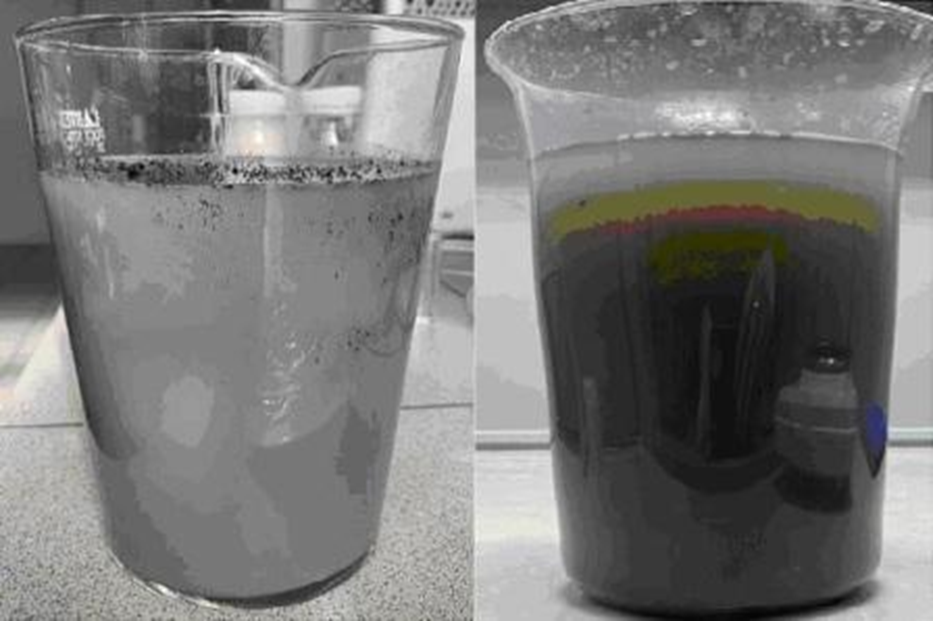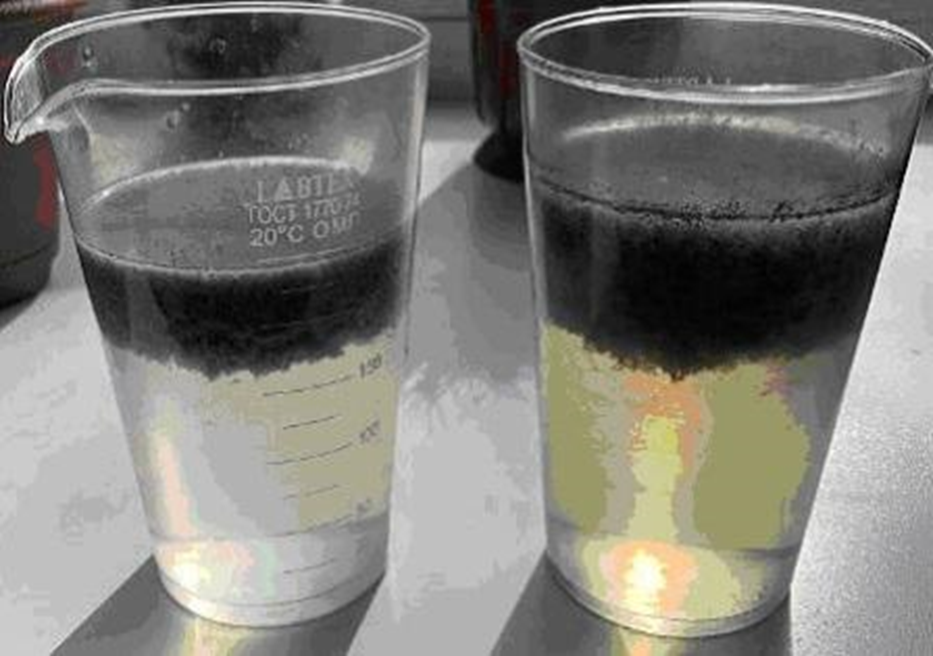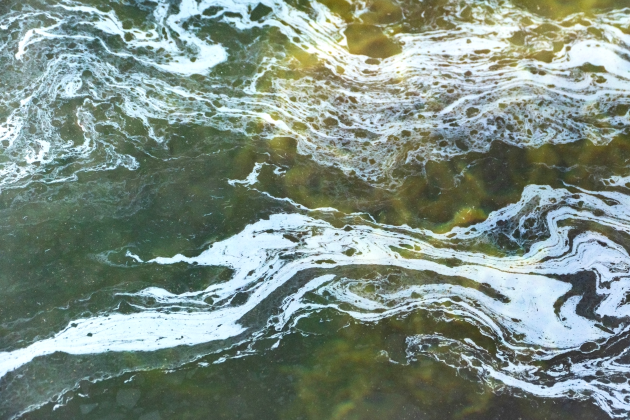Biomicrogels® reagents proved to be successful in treatment of spent metalworking fluids for international steel producer
Recycling and disposal of used cutting fluids (metalworking fluids), which are basically a stable water-oil emulsion, is a serious problem for metallurgical enterprises that generate such waste in quantities from 10 to 100 thousand tons per year. Cutting fluids, which are widely used in the production process, lose their properties over time and need to be disposed of. Due to the excess of the maximum permissible content of organic and surface-active substances (surfactants) in them, such liquids cannot be sent to water treatment facilities, but must be disposed of separately.
The engineers of SPC BioMicroGel suggested the metallurgic plant to use a reactor-type solution for neutralization and processing spent cutting fluids based on Biomicrogels® BMG-P2 coagulant, which offers a more efficient and economical way to separate the coolant emulsion and decompose it to the required parameters without heating.
According to the World Wildlife Fund (WWF), this metallurgical plant is among the 10 most sustainable mining and metallurgical companies in Russia. Therefore, it has set quite ambitious goals:- Compliance with environmental regulations (Maximum Permissible Concentration, in purified water);
- Improved efficiency of waste management;
- Reduction of waste volume sent for recycling;
- Reduction of the negative impact on the environment through reduced CO2 emissions.
The whole treatment process at the BMG CL 3 pilot plant is as follows: to destroy surfactants, the emulsion is exposed to a mineral acid solution, which also reduces the pH level. By adding the BMG-P2 working solution, oil drops contained in emulsion are captured and encapsulated, and then they are coagulated and flocculated, i.e. these oil products are transformed into insoluble state in the form of sediment or flotation sludge. Next is the settling stage, during which water and oil products are separated due to the difference in their density (depending on the composition of oil products and suspended particles, they either remain at the bottom or float up). Water and oil products are then directed to separate containers. After that, the pH values are restored to the required level – 6.5-8.5 – by adding an alkali solution.
The volume of sediment is 10-12% vol. (volume percent) depending on the content of contaminants in the original cutting fluid. After sedimentation the precipitate enters the filter press for complete dehydration. This technology makes it possible to reduce the amount of waste by more than 10 times of the original coolant volume, and get up to 1.0% waste from the original metalworking fluid at the output. Finally, the compacted sediment of petroleum products is then sent for disposal.
The solution, suggested by SPC BioMicroGel, allows the metallurgical plant to achieve the required goals during the cutting fluids treatment:
- Compliance with the standards regulating the content of petroleum products in the discharge of treated water or in the water cycle – no more than 20 mg/dm3;
- Reduction of the cutting fluid disposal cost by 2 times;
- Reduction of the amount of generated waste by 10 times from the initial volume of cutting fluid to 1.0% vol;
- Decomposition of the cutting fluid without additional heating - elimination of СО2 emissions.
It is especially important that Biomicrogels® BMG-P2 coagulant separates even the most stable emulsions and is completely safe for the environment. This combination is possible because Biomicrogels® are produced from polysaccharides, which are obtained by complex processing of vegetable raw materials: sugar beet pulp and apple pomace. Tests carried out in accordance with GOST 32509-2013 standard “Surface-active agents. Method for determination of biodegradability rate in aquatic environment” confirmed the rapid (1st class) and complete biodegradability of Biomicrogel®️ BMG-P2 coagulant.
Table 1. Characteristics of Biomicrogel® BMG-P202-03 Coagulant
|
Parameter |
Value |
|
Aggregate state |
Homogeneous liquid without foreign inclusions |
|
Solution concentration, % |
2 |
|
Hydrogen indicator of an aqueous solution, pH |
4.0-5.0 |
|
Viscosity of working solution, mPa*s |
40.0-50.0 |
|
Density of working solution, g/cm3 |
1.01 – 1.03 |
|
The range of working values of the hydrogen index, рН |
2.8 – 8.0 |
|
Operating temperature range, °С |
0 – 85 |
The selection of optimal dosage was carried out using spent cutting fluid samples from two workshops (Figure 1). The characteristics of the samples are presented in Table 2.
Table 2. Characteristics of cutting fluid samples of spent emulsion.
|
Parameter |
Unit of measurement |
Value |
|
|
Sample from workshop 1 |
Sample from workshop 2 |
||
|
Oil products |
mg/dm3 |
980 |
1600 |

Figure 1. Initial samples of spent cutting fluids. The glass on the left contains a sample of coolant from workshop 1; the glass on the right contains a sample of coolant from workshop 2.
The separation of the cutting fluid was carried out at room temperature, since the BMG-P202-03 coagulant, unlike most other reagent solutions, does not require additional heating of the fluid. The samples were first exposed to a dilute acid solution to destroy the surfactant. Then, sequentially and with constant stirring, the following reagents were added: Biomicrogels® BMG-P202-03 coagulant and Activator-01. The addition of BMG-P202-03 resulted in an instantaneous decomposition of the cutting fluid sample with the formation of large floating flakes (Fig. 2). As a result of the coagulation process, the oil products transformed into an insoluble state, forming precipitate.

Figure 2. Cutting fluid samples after treatment with Biomicrogels® reagents
The optimal dosage of reagents is selected based on the customer's requirements for the content of oil products in the treated wastewater. The standard requirement for the content of oil products is not more than 20 mg/dm3.
Samples of clarified water were tested by an accredited analytical laboratory to confirm the quality of purification. The results of the analysis of these sample are shown in Table 3.
Table 3. Analysis of the purified samples
|
Indicator |
Unit of measurement |
Result |
|
|
Sample from workshop 1 |
Sample from workshop 2 |
||
|
Oil products |
mg/dm3 |
10.2 |
16.0 |
|
Volume of sediments after dehydration (from initial volume of cutting fluid) |
% vol. |
1.0 |
1.0 |
Analytical control has shown that concentration of oil products in the clarified water is 20-40% lower than required by customer. In this regard, it was concluded that the optimal dosage of the coagulant would be 150 mg/dm3.
When disposing the spent cutting fluid generated at metallurgical plants, the use of a ready-made Biomicrogel® solutions based on BMG-P202-03 Coagulant allows companies to achieve the following results:
- Reduce the content of oil products in clarified water after treatment by 20-40% below the required standard set by the customer - less than 20 mg/dm3;
- Reduce the volume of waste by 10+ times the volume of the initial sludge, to a value of 1% vol. from the spent cutting fluid received for recycling;
- Reduce disposal costs by 2 times. Eliminate the negative impact on the environment by reducing carbon dioxide emissions by 2.5 thousand tons of СО2 per year, due to energy-efficient process without additional heating / evaporation of spent cutting fluids
“The advantages of introducing the BMG-P2 coagulant into the production process of metallurgical enterprises are obvious,” summed up Alexander Yagupov, Ph.D. in Engineering, Technical Director of SPC BioMicroGel. “First of all, it allows to return the larger volume of purified water back to the water cycle of the enterprise. Secondly, we are talking about reducing the amount of waste for recycling. Thirdly, by eliminating the evaporation process, energy consumption is reduced thus decreasing СО2 emissions. Therefore, the use of BMG-P2 is fully consistent with the principles of “green” agenda and decarbonization of industries formulated at the global level.”
In terms of ESG, the benefits of using Biomicrogels® BMG-P2 compared to traditional evaporation methods of treatment are associated with the absence of greenhouse gas emissions due to the fact that BMG-P2 remains operational in a wide temperature range (from 0°C to +85°C). This makes it possible to purify water to values of less than 10 mg/l in a more environmentally friendly manner and at a lower cost than using other technologies that require higher temperatures of the cutting fluid. Since this process does not demand additional heating of the emulsion, it reduces the energy costs, and also decreases release of hydrocarbons as well as acid vapors into the environment. According to the company's experts, the potential for reducing greenhouse gas emissions when using Biomicrogel® reagents compared to evaporation technology is 17.8 million tons of СО2-eq. per year.
In addition to the metallurgical industry, the solutions from SPC BioMicroGel allow reducing CO2 emissions in all the scopes (Scope 1, Scope 2, Scope 3) in such applications as industrial wastewater treatment from oils and oil products, oil spill response, as well as in the vegetable oils production.
As a reminder, the carbon emissions of industrial enterprises are categorized into three groups or ‘Scopes’: The first scope (Scope 1) is direct emissions from the enterprise during production. The second scope (Scope 2) relates to energy consumption. It is important to understand from what sources the company receives its energy: coal plants, nuclear power plants, hydroelectric power plants, etc. The third scope (Scope 3) includes the entire chain of the product life cycle: procurement of raw materials, delivery, sale, use, disposal, etc., that is, emissions not directly related to the manufacturer.Source: https://www.sovmash.com/node/1884




